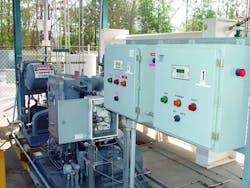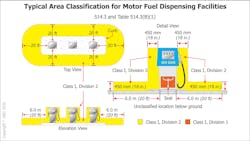Classification of Hazardous (Classified) Locations
Determining whether or not an area is going to be considered a hazardous (classified) location is critical to the type of construction, wiring methods involved, and the overall safety of the intended occupants. I remember past instances in my role as an electrical inspector when I would receive the fairly common phone call from an electrical contractor asking me the question I couldn’t answer: “What is going to be your ruling as far as the classification of this building we are working on in your jurisdiction? Are you going to rule it to be a Class I, Division 1 or a Class I, Division 2 location?”
First and foremost, the classification of an area should have been determined long before that type of phone call takes place between the electrical inspector and the installer. It should be understood that “approval of” and “design of” electrical installations in hazardous (classified) locations are two different tasks and responsibilities. It is also important to realize that the area classification part of the design would likely include a design team rather than a single design person like the authority having jurisdiction (AHJ). This design team could easily include personnel from fields such as electrical (including the AHJ), process, mechanical, fire protection, and structural design. Area classification and design of the electrical systems installed within that area is the responsibility of the owner’s representative(s) and the design team. That design should include proper documentation (see NEC Sec. 500.4). Acceptance of the determined classification and enforcement of NEC requirements of said classification is the responsibility of the AHJ once the design team has determined the area classification. Proper application of the NEC requirements will necessitate everyone involved in the project working together for the installation to be effectively completed.
In looking at the history of how Code requirements for hazardous (classified) locations evolved, it is interesting to note that in the 1920s and early 1930s, hazardous (classified) locations were referred to in the NEC as “extra hazardous locations.” Everything else regarding the use of electricity was “hazardous,” but for reasons of shock and fire — not for explosions. One of the first extra hazardous (classified) location requirements in the NEC was associated with flammable inhalation anesthetic gases for use in health care facilities.
Area classification often is the result of a risk analysis of a particular location or area to determine the likelihood that an explosion hazard exists. Areas are generally hazardous (classified) locations if ignitable concentrations of flammable gases, flammable liquid-produced vapors, combustible liquid-produced vapors, combustible dust, or ignitable fibers/flyings — either in suspension in the air or other accumulations that present explosion or fire hazards — exist or could exist.
In addition to determining the likelihood that an ignitable concentration exists, the area classification provides an accurate and defined description of the material (gas, vapor, dust, etc.) so that appropriate electrical systems and equipment can be selected for the design and installation. Determining who is responsible for a risk analysis is a common question. As stated earlier, typically more than one individual is responsible for determining the area classification.
The degree of the hazard is usually determined by the gas, vapor, or other substance and the associated process that will produce (or is likely to produce) atmospheres or accumulations of these materials that can be ignited.
The NEC requires proper documentation of areas designated as hazardous (classified) locations. This documentation can be in several acceptable formats, but it must be acceptable to the AHJ. Normally, this documentation is in the form of written documents, accompanied by blueprints or drawings that graphically show the area classifications. This documentation must be available to those authorized to design, install, inspect, maintain, or operate electrical equipment at that location (see NEC Sec. 500.4).
Electrical installations in hazardous (classified) locations, if not installed to meet the minimum requirements of the applicable codes and standards, can be hazardous to persons and property. Electricity is a source of ignition for atmospheres that have the potential to explode. Various hazardous (classified) locations are detailed in Chapter 5 of the NEC.
This article provides a brief review of the basics of determining area classifications and who would determine those area classifications. It is not the responsibility of the AHJ to determine an area classification. Once that area classification has been determined, it is the responsibility of the AHJ to approve or agree with the area classifications, and then apply the appropriate NEC requirements to those said hazardous (classified) locations.
L. Keith Lofland is the director of education, codes and standards for IAEI, Richardson, Texas. He represents IAEI as chairman of NFPA’s Code Making Panel (CMP) 7 for the National Electrical Code (NEC), serves on NFPA’s Electrical Section Executive Committee, and is a member of UL’s Electrical Council. He is also the principal author of several IAEI publications, including IAEI’s NEC Analysis of Changes. Prior to his position with the International Office of IAEI, Lofland spent 16 years with the City of Garland (Texas) serving as their chief electrical inspector. He holds a master electrician license from the State of Texas. He can be reached at [email protected].
Inspector Intel articles are provided by the International Association of Electrical Inspectors (IAEI), www.iaei.org, a membership-driven, non-profit association headquartered in Richardson, Texas, that promotes electrical safety throughout the industry by providing education, certification of inspectors, advocacy, partnerships, and expert leadership in electrical codes and standards.
About the Author
L. Keith Lofland
Director of Education, Codes and Standards
L. Keith Lofland (retired) is the former director of education for IAEI. Keith represented IAEI as Chairman of NFPA’s Code Making Panel (CMP) 7 for the National Electrical Code (NEC) for the 2020 and the 2023 NEC. Previously, he served 3 Code cycles as a member of CMP-9. In his career, Keith served on NFPA’s Electrical Section Executive Committee and as a member of UL’s Electrical Council. He was the principal author for six Code cycles of several IAEI publications including IAEI’s NEC Analysis of Changes. Prior to his position with the International Office of IAEI, Keith spent 16 years with the City of Garland (Texas) serving as its chief electrical inspector. Keith holds a Master Electrician license from the State of Texas. He also has obtained Electrical Inspector certifications from IAEI and ICC. Keith received the “Building Official/Building Inspector of the Year” award in 1999 from the Construction Research Center-University of Texas at Arlington. Keith received the Gold Roadrunner award in 2014 for development and promotion of the NEC as a presenter and educator.


